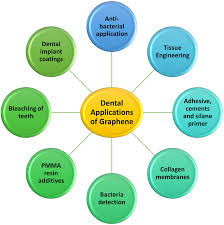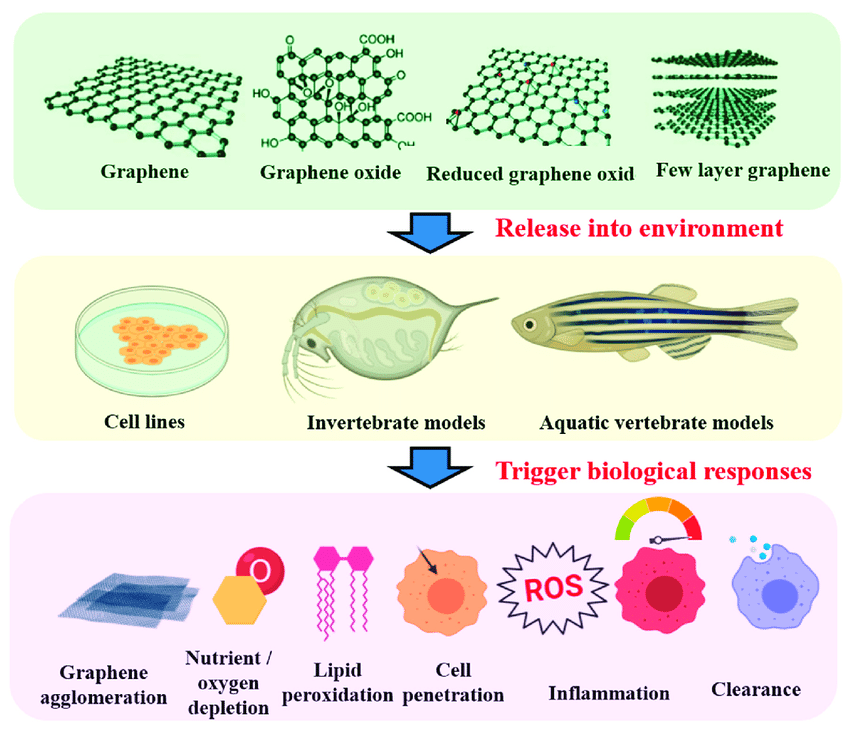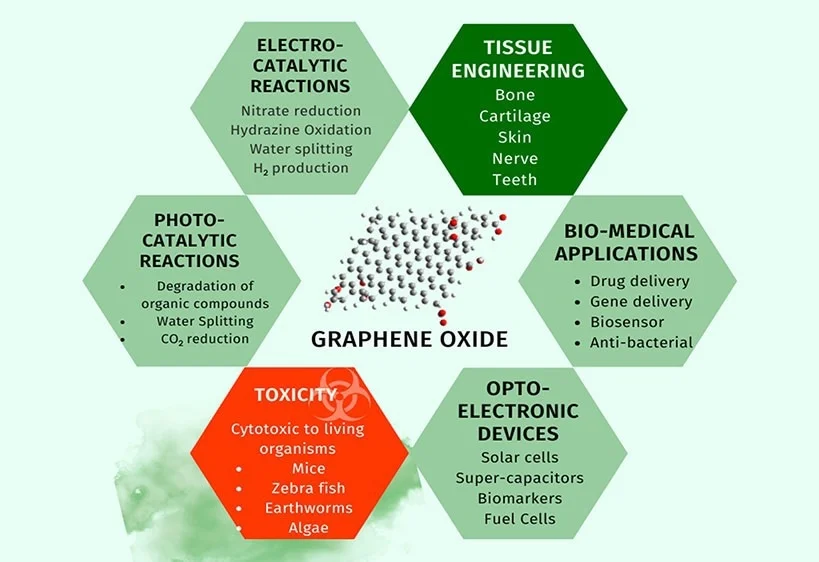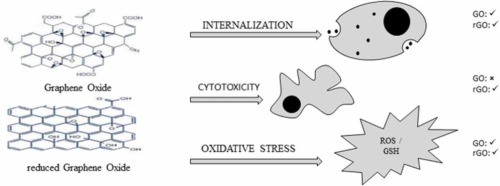Updated with new information on November 27, 2024
What is Graphene oxide (GO) and how is it used in medicine?

Graphene oxide (GO), which is synthesized by fast oxidation of graphite, is known as an ideal nanocarrier for the efficient delivery of drugs/genes. Gene therapy is a novel approach utilized in the treatment of genetic disorders, such as Parkinson’s disease, cystic fibrosis, and cancer.
Owing to the unique properties, such as high specific surface area, superior biocompatibility, enriched oxygen-containing groups, and stability, scientists have been able to load genes/drugs via chemical conjugation or physisorption methods. Recently, researchers have developed polyethyleneimine-modified GO for gene delivery.
Graphene derivatives, e.g., reduced GO (rGO) and doped graphene, have been utilized for the detection of biomolecules, such as amino acids, dopamine, thrombin, and oligonucleotide. GO-based biosensors are also used to identify DNA. Additionally, scientists have used GO for bioimaging of cellular uptake, of polyethylene glycol-modified GO, during drug delivery.

GO has also been found to have wound closure and wound healing properties. It is now used in wound dressings produced from biomechanically active self-healing injectable hydrogels containing polydopamine-coated reduced graphene oxide (rGO-PDA).
Graphene Oxide in Dentistry

GO use in dentistry is said to be “promising” due to its antibacterial properties, but is mostly at the research stage. Currently there is research on using GO in dental implants, bone regeneration, dental adhesives, resins, and bleaching of teeth. Researchers are using GO-containing dental biosensors to detect viral and bacterial markers, diseases like cancer, and drugs. There are experiments using graphene oxide based hydrogels to improve the effectiveness of lidocaine and other dental anesthetics.
Graphene Oxide Toxicity

In general, the severity of this nanomaterial’s toxic effects varies according to the administration route, the dose to be administered, the method of GO synthesis, and its physicochemical properties. Minimal research is available regarding the safety of graphene, partly because the medical use of graphene is still in its early developmental stage.
GO Toxicity: Animal Studies

2022 fly study: Flies were used as a model organism to study GO (graphene oxide) toxicity at relatively low concentrations. They found that GO exposure led to remarkable weight loss, delayed development, retarded motion, and shortened lifespan of these flies.
Recently, a new study evaluated the toxicity of GO in the rat cardiomyoblast H9c2 cell line. It demonstrated that GO induced cardiotoxicity, mitochondrial disruption, generation of reactive oxygen species, and DNA interactions.

Studies have found that there are a lot of animal species for which GO showed some cytotoxic nature (it is toxic to and damages the body’s cells). GO may promote acute inflammatory reactions and chronic injury by interfering with the normal physiological functions of important organ systems. The results of various in vitro studies have demonstrated that graphene nanomaterials may alter cell viability and morphology, destroy the integrity of cell membranes, and enter lysosomes, mitochondria, nuclei and endoplasmic reticulum to induce DNA damage and cell apoptosis.
GO also possesses neurotoxic potential, especially on neurotransmitters and AFD neuron in C. elegans. In a recent study, researchers identified behavioral alterations in mice exposed to GO, such as increased anxiety, decreased motor coordination, reduced locomotor activity and balance disorders.
How is GO Metabolized/Excreted?
The excretion of graphene nanoparticles from the body is still an area of intense study as the excretion mechanisms vary greatly depending on factors such as the size and shape of the nanoparticles. Many smaller nanoparticles are able to be easily excreted through the urine or feces, while larger sized nanoparticles tend to accumulate in the liver and spleen for up to several weeks before being excreted.
So is GO Toxic?
Yes, graphene oxide is toxic although some people will be able to detox it from their bodies better than others, depending on level of exposure and how well their detox pathways are working.
Symptoms of Graphene Oxide Poisoning (Toxicity)

Graphene oxide is a relatively new technology, so more studies need to be done in order to understand what the symptoms of graphene poisoning or toxicity are.
However, we do know, based on the studies done so far (see references section below) that graphene oxide can negatively affect the internal organs including the liver, heart, brain, lungs, and DNA. Thus there could be many symptoms associated with graphene oxide toxicity, including chronic respiratory issues, pulmonary fibrosis, heart problems, neurological problems, liver damage, cancer, and death.
How to Detox Graphene Oxide
Melatonin
A scientific study done in 2011 (see reference below) showed that melatonin, which is a powerful antioxidant, was able to reduce graphene oxide toxicity.

Melapure® Melatonin: Patented, USP Pharmaceutical Grade: 30mg per day taken two hours before bed. Melapure is a powerful antioxidant and a biocompatible competitor of hydrazine in reduction of graphene oxide (GO). Melatonin is a chronobiotic, that is, an agent that can cause adjustments of the body clock. It is also cyto-or cell protective and can reverse the inflammation typically seen in neurodegenerative disorders and aging. Melatonin is a potent antioxidant that aids the detoxification of the brain through the glymphatic system (the brain’s waste disposal apparatus that works while you sleep).
Other Antioxidant Supplements for Graphene Oxide Toxicity

There was a recent study done in 2024 (see references below) that studied a number of Antioxidant Supplements including
Vitamin C (Ascorbic Acid)
Green Tea
Glutathione
They can be used to mitigate the toxicity of graphene oxide. These antioxidants help protect the body from the toxic effects of graphene oxide including cell damage, oxidative stress and inflammation. They also help to neutralize free radicals and help to maintain cellular integrity.
Homeopathic Detox Therapy
In recent years, many homeopaths are using Homeopathic Detox Therapy methods to detox toxins and poisons. This method uses a homeopathic version of the offending toxin (e.g. graphene oxide) in different potencies/strengths, given over a period of weeks.
References
Understanding the Health Risks of Graphene. By Dr. Priyom Bose, Ph.D. May 16 2022. AZoNano.
There is Something Wrong with our Children by Eldon Dahl, September 27th, 2023. Doctor’s Choice.
